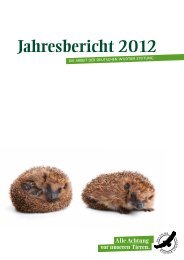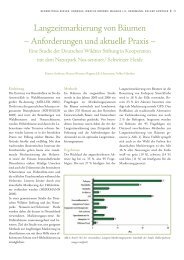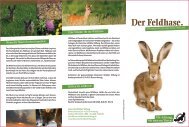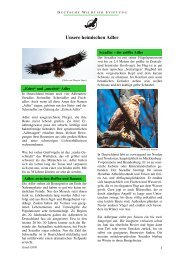Zur Biologie und Ökologie des Feldhasen - Deutsche Wildtier Stiftung
Zur Biologie und Ökologie des Feldhasen - Deutsche Wildtier Stiftung
Zur Biologie und Ökologie des Feldhasen - Deutsche Wildtier Stiftung
Erfolgreiche ePaper selbst erstellen
Machen Sie aus Ihren PDF Publikationen ein blätterbares Flipbook mit unserer einzigartigen Google optimierten e-Paper Software.
HARTL, G. B. (1991): Genetic polymorphism of sorbitol dehydrogenase in the brown hare and the distribution of the variation<br />
in Central Europe. Biochemical Genetics 29: 49-54.<br />
HARTL, G. B., SUCHENTRUNK, F., WILLING, R., PETZNEK, R. (1995): Allozyme heterozygosity and fluctuating asymmetry in<br />
the brown hare (Lepus europaeus): A test of the developmental homeostasis hypothesis. Philosophical Transactions of<br />
the Royal Society of London Series B - Biological Sciences 350: 313-323.<br />
HARTL, G.B., FERRAND, N. (1993): Genetic Polymorphism of Transferrin (TF) and the Haemoglobin Alpha-Chain (HBA) in<br />
the Brown Hare (Lepus europaeus). Animal Genetics 24 (6): 439-440.<br />
HARTL, G. B., MARKOWSKI, J., KOVÀCS, G., GRILLITSCH, M., WILLING, R. (1990): Biochemical variation and differentiation in<br />
the Brown hare (Lepus europaeus) of Central Europe. Z. Säugetierk. 55: 186-193.<br />
HARTL, G. B., MARKOWSKI, J., SWIATECKI, A., T JANISZEWSKI, T., WILLING. R. (1992): Genetic Diversity in the Polish Brown<br />
Hare Lepus europaeus PALLAS, 1778 - Implications for Conservation and Management. Studies on the European Hare.<br />
Acta Theriologica 37, 1-2: 15-25.<br />
HARTL, G. B., SUCHENTRUNK, F., NADLINGER, K., WILLING, R. (1993): An integrative analysis of genetic differentiation in the<br />
brown hare Lepus europaeus based on morphology, allozymes, and mitochondrial DNA. Acta Theriologica 38 (2): 33-<br />
57.<br />
HARTL, G. B., SUCHENTRUNK, F., WILLING, R., GRILLITSCH, M. (1989): Biochemische-genetische Variabilität <strong>und</strong><br />
Differenzierung beim <strong>Feldhasen</strong> (Lepus europaeus) in Niederösterreich. Tierärztl. Mschr. 76: 279-284.<br />
HATTEMER, H. H., BERGMANN, F., ZIEHE, M. (1993): Einführung in die Genetik für Studierende der Forstwissenschaft. J. D.<br />
Sauerländer's Verlag. Frankfurt am Main.: 492 S.<br />
HATTEMER, H. H., GREGORIUS, H. R., ZIEHE, M., MÜLLER-STARCK, G. (1982): Klonanzahl forstlicher Samenplantagen <strong>und</strong><br />
genetische Vielfalt. All. Forst- u. J.-Ztg. 153: 183-190.<br />
HAUPT, W., STUBBE, I. (1999): Beitrag zum Endoparasitenbefall <strong>des</strong> <strong>Feldhasen</strong> (Lepus europaeus PALL.) in zwei<br />
unterschiedlichen Jagdgebieten. Beitr. Jagd u. Wildf. 17: 136-140.<br />
HEDIGER, H. (1948): Die Zucht <strong>des</strong> <strong>Feldhasen</strong> (Lepus europaeus PALLAS) in Gefangenschaft. Physiologica comparata et<br />
oecologia 1: 46-62.<br />
HELL, P., FLAK, P., SLAMECKA, J. (1997): Korrelation zwischen der Streckenentwicklung <strong>des</strong> Rot- <strong>und</strong> Rehwil<strong>des</strong> sowie <strong>des</strong><br />
<strong>Feldhasen</strong> <strong>und</strong> ihrer wichtigsten Prädatoren in der Slowakei in den Jahren 1968-1995. Z. Jagdwiss. 43: 73-84.<br />
HELL, P., SLAMECKA, J., FLAK, P. (1997): Einfluss der Witterungsverhältnisse auf die Strecke <strong>und</strong> den Zuwachs <strong>des</strong><br />
<strong>Feldhasen</strong> in der südwestslowakischen Agrarlandschaft. 22: 165 - 172.<br />
HENRIKSEN, P., GAVIER, D., ELLING, F. (1989): Acute necrotising hepatitis in danish farmed hares. Vet. Rec. 125: 486-487.<br />
HERMAN, C.S., VALONE, T. J. (2000): The effect of mammalian predator scent on the foraging behavior of Dipodomys<br />
merriami. 91. Kopenhagen.: 139-145.<br />
HIRAKAWA, H. (2001): Coprophagy in leporids and other mammalian herbivores. 31: 61-80.<br />
HÖFLECHNER-POLTL, A., HOFER, E., AWAD-MASALMEH, M., MULLER, M. STEINECK, T. (2000): Tularämie <strong>und</strong> Brucellose bei<br />
<strong>Feldhasen</strong> <strong>und</strong> Füchsen in Österreich. Tierärztl. Umschau 55: 264-268.<br />
HÖGLUND, N. H. (1957): Svenska jagareförb<strong>und</strong>ets viltmärkiningar 1955 och 1956. 283-317.<br />
HÖHN, H., HERZOG, A. (1971): Der Karyotyp <strong>des</strong> Europäischen <strong>Feldhasen</strong>. Z. Jagdwiss. 17: 27-31.<br />
HÖLZINGER, J. (1987): Bd. 1.1-1.3. Gefährdung <strong>und</strong> Schutz. In: HÖLZINGER, H., et al. (1987-1995): Die Vögel Baden-<br />
Württembergs. Ulmer Verlag. Stuttgart.<br />
HOFFMANN, D., SCHMÜSER, D. (2000): Monitoringbericht <strong>Wildtier</strong>kataster. In: Ministerium für Umwelt, Natur <strong>und</strong> Forsten<br />
<strong>des</strong> Lan<strong>des</strong> Schleswig-Holstein (Hrsg). Jagd <strong>und</strong> Artenschutz. Jahresbericht 2000. Kiel. S. 28-29.<br />
HOLLDACK, K., GRESS, W. (1988): Die Bedeutung <strong>des</strong> Arterhaltungswertes (AEW) für die Bewertung der Prädation. Z.<br />
Jagdwiss. 34: 205-211.<br />
HULBERT, I.A.R., ANDERSEN, R. (2001): Food competition between a large ruminant and a small hindgut fermentor: The case<br />
of the roe deer and mountain hare. 128. Berlin.: 499-508.<br />
HULL, D. (1965): Oxygen consumption and body temperature of new-born rabbits and kittens exposed in cold. Comparative<br />
Physiology of Thermoregulation 3: 167-200.<br />
HUTCHINGS, M.R., S HARRIS (1995): Does hunting pressure affect the flushing behaviour of brown hares (Lepus europaeus)?.<br />
Journal of Zoology 237 (4): 663-667.<br />
IMMELMANN, K. (1983): Einführung in die Verhaltensforschung. 3. Aufl. Pareys Studientexte 13. Berlin u. Hamburg.: 238 S.<br />
IPPEN, R. (1999): Bericht über das Arbeitstreffen zu Fragen der Hasenerkrankungen in Uppsala (Schweden). Beitr. Jagd u.<br />
Wildf. 17: 134-136.<br />
82








